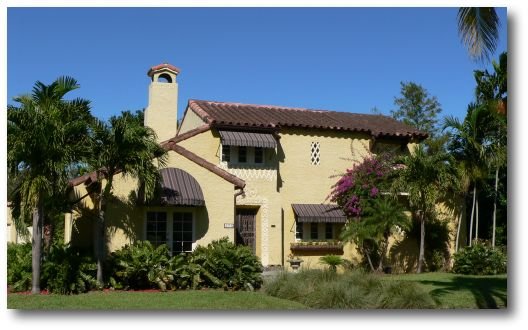
What is the right type of awning for a historic home?
I get asked what the right type of awning is for historic homes all the time. I am the Miami Architectural REALTOR after all, so ask away! Anything to do with architecturally significant real estate or historic homes in Miami is my FORTE. I would love to be able to tell you that any awning company will be able to guide you in the right direction but that’s not true at all. I’ve seen awning companies recommend horrible options that are not historically appropriate and do not compliment existing historic features and fenestrations.
The right type of awning for a historic home
There are basic rules and some NO NO’s (like anything else). Please understand that I am not making up these rules as I go. Restorations should be consistent with The Secretary of Interior’s Standards for Rehabilitation, and as I’ve said before, educating yourself about historic features and their standards should be an important part of owning a Miami Beach historic home. These standards include examples of correct and incorrect repairs and replacement of roofs, windows materials and other elements. Now to awnings! The primary purpose of an awning is more functional rather than decorative, although I have seen very boring facades brought to life with beautiful awnings. Traditionally, awnings were installed only where necessary for shade and weather protection. Please keep this in mind when considering awnings for your historic home. There is nothing worse than seeing every single fenestration (window and door opening) covered by an awning. This is what I call “overkill”.
The basic rule for awnings is shape
- If the door or window opening is square or rectangular, only install rectangular or straight awnings, never ARCHED!
- If the door or window opening is arched, only install arched awnings, never STRAIGHT!
Pretty simple, don’t you think? Here are some examples of awnings installed in Mediterranean Revival homes around Miami Shores. 


 These examples show the correct use of straight or rectangular awnings installed on rectangular doors and windows.
These examples show the correct use of straight or rectangular awnings installed on rectangular doors and windows. 
Never install an arched awning on a rectangular opening
 This is a beautiful example on an arched awning placed inside an arched opening. There are 2 types of arched awnings and one of them should NEVER be used in residential applications, and that’s the bubble type awning. For those of you that have these, I apologize because you probably did not know any better. Bubble type awnings are more appropriate for commercial applications.
This is a beautiful example on an arched awning placed inside an arched opening. There are 2 types of arched awnings and one of them should NEVER be used in residential applications, and that’s the bubble type awning. For those of you that have these, I apologize because you probably did not know any better. Bubble type awnings are more appropriate for commercial applications. 


Is there an appropriate color for awnings used on historic homes?
As for the color of awnings, this is definitely subjective. The stripped fabric is usually my preference, but in very busy facades, I have found stripes to be overwhelming. A lot of people think that solid colors are more formal and appropriate, but I really think it depends on the particular architectural elements of the house.
One piece of advise is to get a big swatch of fabric when choosing the color (especially if choosing stripes), most swatch books will have tiny samples that will make it very difficult to choose. A good awning company should be happy to supply a big sample of the fabric. An awning can bring so much life to a facade, and can take the “boring” factor out whether you have a historic home or not. They can also be functional and energy efficient. There are many types and they are easy to maintain, just make sure you don’t overdo it and think of the “appropriateness factor” before installing.
Also take a look at “The Use of Awnings on Historic Buildings – Repair, Replacement & New Design“, for great detailed information. ** Leer en Español **
originally published 9/25/2015

What is the right type of awning for a historic home? http://t.co/1slXqVfPCi http://t.co/FoTxzDfsPI
What is the right type of awning for a historic home? http://t.co/vu4SGSEfNe http://t.co/04DQ7Xslbg